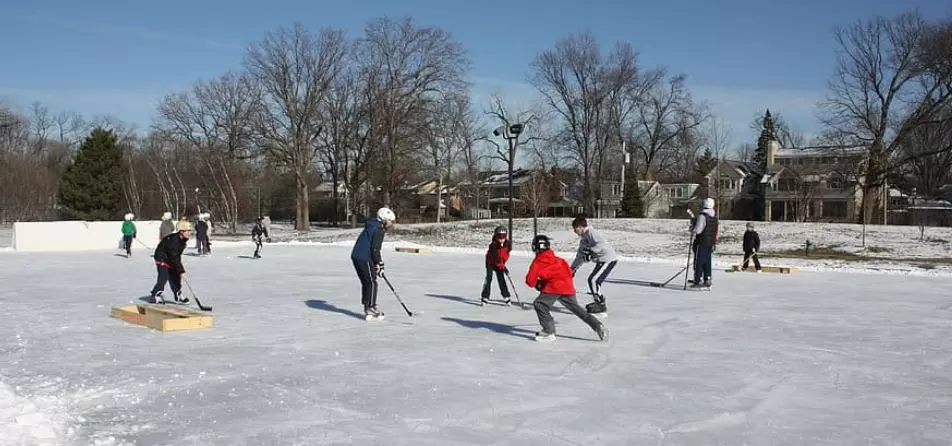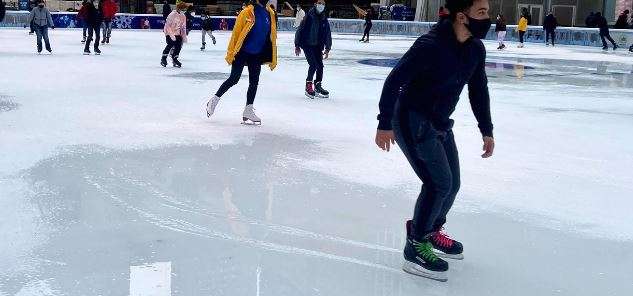Last updated on December 16th, 2021 at 09:05 am
How Skating is Possible on Ice: What Type of Force is Ice Skating? Watching ice skaters move can be exciting, especially the moves and jumps involved in figure skating. It is a fun and graceful recreation sport that may look complicated but once you try it, you’d realize it’s simple. It helps you relax and you will find yourself smiling at how much fun you are having. Read this also Are Skating Rinks Cold
Skating is possible on ice because of a force applied. You may be wondering what this force is. You may also be trying to figure out what type of force causes an ice skater to begin to move? How do you professionally skate on ice? Is ice skating harder than roller skating? At what age should you start figure skating? What age is too late to start figure skating? Or How to start competitive figure skating? Read on to get the answers to these questions and more. Related: Can Skating Help Lose Weight and 17 Balance Exercises for Figure Skaters
What Type of Force Causes an Ice Skater to Begin to Move?
The force that allows ice skaters to move, continue in motion, and carry out different movements effortlessly on ice is friction.
It is friction that also allows ice skaters to achieve speed when skating. Ice is slippery, and so in order to move and not fall, there has to be traction caused by enough friction. This works by the skater’s conscious move of the leg muscles against the blades. The sharp blades on the ice skate dig into the ice allowing the skater to stand and move forward when the necessary friction has been created.
The friction needed to begin is low. It creates resistance when the ice skates slide against the ice. This is what propels the skater to glide along, depending on the force applied, and to continue without stopping.
How Do You Professionally Skate on Ice?
Ice skating can seem difficult from afar but with the right commitment to continuous and frequent training, and patience, you are sure to skate professionally. To start you would need a helmet and a mastery of the basic moves but after you cross this stage you’d fly on ice. However, there are some things you need to consider and do;
1. Pick the Right Skate Shoes
The right skate shoes are skates that properly fit you. They are available in all shoe sizes so don’t worry about not finding your size. There are also different designs you can pick from. Pick the one that reflects your personality and you feel comfortable in.
2. Wear the Right Clothes
When going to ice skate, your choice of clothes affects your weight and your ability to move easily, Avoid any heavy clothing or clothes that get heavy when wet. Light and fitted clothes are perfect and you don’t need to worry about getting cold. Once you start skating your body gets warm. Put on something you can easily remove in case you get sweaty, like a light coat or jacket or a fitted sweater.
Don’t forget to put on tights or microfiber socks to keep your feet warm. Microfiber socks because cotton socks will get socked up moisture and you need a little moisture to keep your feet warm.
3. Master the Basics
Knowing how to start, stop, glide and fall are the basics of ice skating. Knowing the right body posture is also important. Once you’ve mastered all this, the only thing left is to practice to get perfect. The practice would help you acquire all the techniques you need to shine as a professional ice skater.
Is Ice Skating Harder Than Roller Skating?
While some persons find roller skating harder than ice skating, others find ice skating harder than roller skating. It all depends on preference. What makes ice skating harder than roller skating is the shoes. Roller skates have four (4) wheels that make balancing easy than ice skates with sharp, thin blades. However, if you can master balancing on ice skates you would realize how easy it is.
At What Age Should You Start Figure Skating?
To be honest, there is no maximum age or age barrier for when you can start figure skating. If at 90, you develop a passion to start, and you are strong enough and can carry yourself, you are good to go. Once a child of 3 or 4 years can listen and take instructions then he or she can start learning to figure skate.
If your goal is to try out at the Olympics then you would need to start at a young age or better, as a child. But if you want to have fun, then any age is just right.
Is it Too Late to Start Figure Skating at 15?
Not at all. It is not too late to start figure skating at 15. As long as you are determined, 15 is still a young age. Besides, no age is too late to start. The only hassle would be performing some stunts or jumps, which can be physically and mentally challenging, but with time and practice, you would get it.
What Age is Too Late to Start Figure Skating?
If you are interested in learning to figure skate, no age is too late to start. All you need to do is to be consistent with practice and even jumps that seem difficult can be mastered in no time. You might not be able to participate in any competition if you didn’t start practicing at a young age but you can still have fun.
Is it Easier to Ice Skate if You Know How to Roller Skate?
If you are planning on stitching from roller skating to ice skating, then I’m sure you are asking because the two sports seem similar. However, the answer is Yes, you can easily ice skate if you know how to roller skate. You can even transfer some of the skills you have in roller skating to ice skating. Besides, the postures, learning, and falling methods are the same.
Do Roller Skates Help With Ice Skating?
If you have a roller skate it can help you practice ice skating. You can use it to work on your confidence, balance, control, and agility.
Roller skates are easier to move in than ice skates, so once you can master your balance and move with a roller skate you can proceed confidently to try it out on an ice skate.
How Do You Transition from Ice Skating to Roller Skating
Ice skating and roller skating are somewhat the same and so transitioning from one to another is easy. Making a transit from ice skating to roller skating will not pose so much difficulty because you already have an idea of what to do. All you have to do is get a roller skate, learn to balance on it, practice, and you are good to go. The body posture is the same and you can apply your skills from ice skating to roller skating.
The difference between them is that roller skating is done on the road while ice skating is done on ice. But this doesn’t mean you can’t make the transition. You may consider roller skating during summer because there’s no snow to practice ice skating.
What is Harder Ice Skating or Roller Skating
Although making this decision is based on individual preference, I would say that ice skating is harder than roller skating. This is because it is easy to navigate wheels than blades. Also, roller skates are known to give better balance because of the wheels. The hardest part in ice skating is having to balance the ice skates and once you can, you will realize that it’s not that hard.
How to Start Competitive Figure Skating?
Starting a competitive figure skater will have you go through training but you need to have a passion for figure skating. You have to realize that it is not all fun and there will be a lot of challenges along the way. Competitive figure skating requires not only physical but mental strength, coupled with discipline and determination. It is your resilience that will keep you going even when you experience failure.
To start, it is important that you do the following:
1. Start with realistic expectations and goals.
2. Consider your age. Starting at the young age of 4 makes it more likely for you to go to the Olympics. However, in figure skating, there are the juvenile, intermediate, novice, junior, and senior levels.
3. Get the right equipment and clothing.
4. Get a good coach.
5. Start with the basics skills. Don’t try to rush into the advanced skills.
6. Eat healthily and remember to drink water.
7. Have a practice schedule and train regularly.
8. Do regular exercises to help you stay flexible and in shape.
9. Get a rink close to your home to avoid missing out on practice.
10. Take sleeping seriously.





